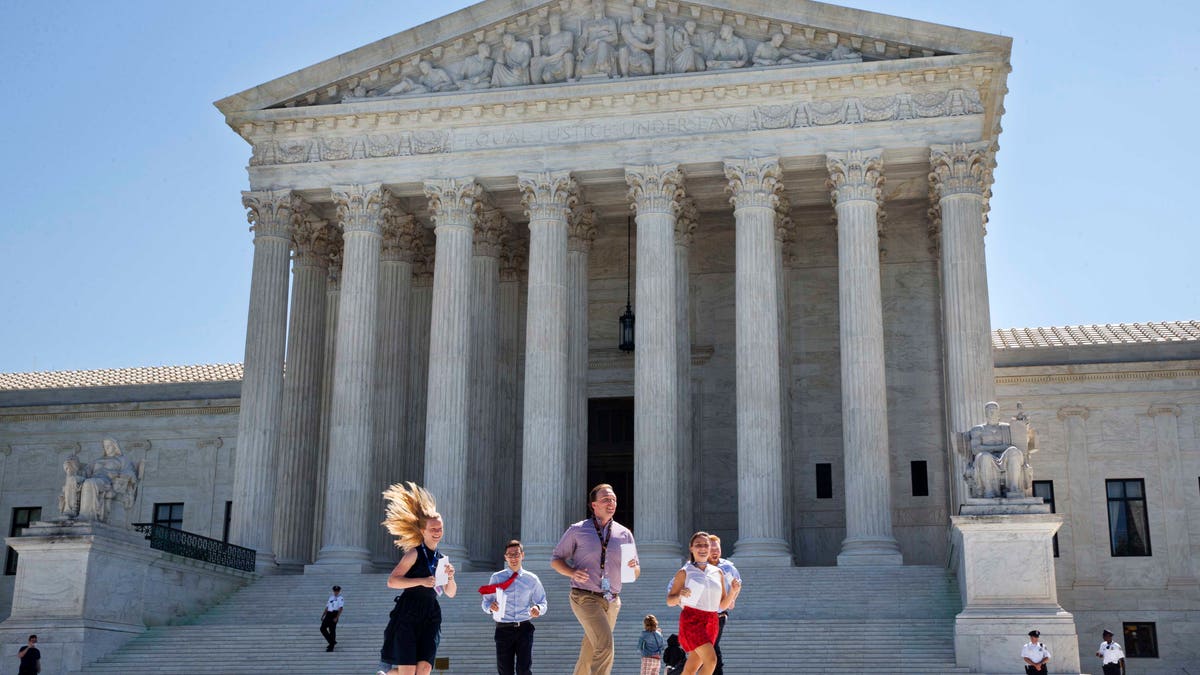
New interns run with a decision across the plaza of the Supreme Court in Washington, Monday June 29, 2015. On Monday, the court upheld Arizona congressional districts drawn by an independent commission and rejected a constitutional challenge from Republican lawmakers and upheld the use of a controversial drug in lethal injection executions Monday, as two dissenting justices said for the first time that they think it's "highly likely" that the death penalty itself is unconstitutional. (AP Photo/Jacquelyn Martin)
WASHINGTON – In a blow to some lawmakers in the Grand Canyon state, the U.S. Supreme Court on Monday sided with Arizona's system of having an independent commission redraw congressional districts.
The 5-4 outcome preserves efforts in 13 states to limit partisan influence in redistricting. Most notably, California uses an independent commission to draw electoral boundaries for its largest-in-the-nation congressional delegation.
Tension over the independent commission erupted after Arizona got an additional House seat primarily because of the state’s population growth, stemming from the increase of Hispanics. The commission redistricted the lines in response by creating four safe GOP districts, two Democratic ones, and three swing ones, two of them held by Democrats. Republicans, who controlled the state legislature, objected to the commission’s redrawn map, preferring instead a fifth safe GOP seat.
Justice Ruth Bader Ginsburg wrote for the court that there is "no constitutional barrier to a state's empowerment of its people by embracing that form of lawmaking."
Justice Anthony Kennedy and Ginsburg's three liberal colleagues joined her opinion.
In dissent, Chief Justice John Roberts accused the majority of approving a "deliberate constitutional evasion."
States are required to re-draw maps for congressional and state legislative districts to account for population changes after the once-a-decade census.
The justices have been unwilling to limit excessive partisanship in redistricting, known as gerrymandering. A gerrymander is a district that is intentionally drawn, and sometimes oddly shaped, to favor one political party.
Rep. Ruben Gallego, an Arizona Democrat, lauded the decision.
“Arizona voters wisely chose to take redistricting out of the hands of the legislature to ensure the diverse communities and interests of our state were fairly represented in Congress," Gallego said in a statement. "I’m glad the Supreme Court agreed with the wisdom of that decision and that Arizonans will continue to have the fair and competitive districts our voters deserve.”
Republicans employed an enormously successful strategy to take advantage of the 2010 census, first by winning state legislatures and then using that control to draw House districts to maximize their power. One measure of their success: In 2012, Republicans achieved a 33-seat majority in the House, even though GOP candidates as a group got 1.4 million fewer votes than their Democratic opponents.
Independent commissions such as Arizona's "may be the only meaningful check" left to states that want to foster more competitive elections, the Obama administration said.
The argument against independent commissions rests in the Constitution's Election Clause, which gives state legislatures the power to set "the times, places and manners of holding elections for senators and representatives."
Only Arizona and California essentially remove the legislature from the process, the National Conference of State Legislatures said, in support of the Republican lawmakers in Arizona.
Lawmakers' only contribution in those states is picking commission members from a list devised by others. In the other states — Connecticut, Hawaii, Idaho, Indiana, Iowa, Maine, Montana, New Jersey, New York, Ohio and Washington — lawmakers either get first crack at drawing districts, approve plans drawn by commissions or appoint commission members of their choosing, the conference said.
Supporters of the commissions point to more competitive races in both Arizona and California since the commissions were created.
The case is Arizona State Legislature v. Arizona Independent Redistricting Commission, 13-1314.
Based on reporting by The Associated Press.
Based on reporting by The Associated Press.
Like us on Facebook





















